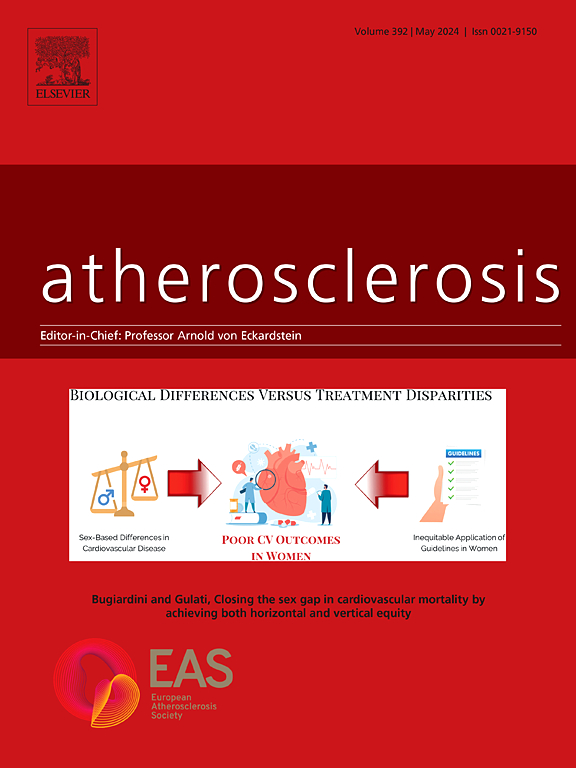Functional interrogation of cellular Lp(a) uptake by genome-scale CRISPR screening
IF 4.9
2区 医学
Q1 CARDIAC & CARDIOVASCULAR SYSTEMS
引用次数: 0
Abstract
Background and aims
An elevated level of lipoprotein(a), or Lp(a), in the bloodstream has been causally linked to the development of atherosclerotic cardiovascular disease and calcific aortic valve stenosis. Steady state levels of circulating lipoproteins are modulated by their rate of clearance, but the identity of the Lp(a) uptake receptor(s) has been controversial.
Methods
We performed a genome-scale CRISPR screen to functionally interrogate all potential Lp(a) uptake regulators in HuH7 cells. Screen validation was performed by single gene disruption and overexpression. Direct binding between purified lipoproteins and recombinant protein was tested using biolayer interferometry. An association between human genetic variants and circulating Lp(a) levels was analyzed in the UK Biobank cohort.
Results
The top positive and negative regulators of Lp(a) uptake in our screen were LDLR and MYLIP, encoding the LDL receptor and its ubiquitin ligase IDOL, respectively. We also found a significant correlation for other genes with established roles in LDLR regulation. No other gene products, including those previously proposed as Lp(a) receptors, exhibited a significant effect on Lp(a) uptake in our screen. We validated the functional influence of LDLR expression on HuH7 Lp(a) uptake, confirmed in vitro binding between the LDLR extracellular domain and purified Lp(a), and detected an association between loss-of-function LDLR variants and increased circulating Lp(a) levels in the UK Biobank cohort.
Conclusions
Our findings support a central role for the LDL receptor in mediating Lp(a) uptake by hepatocytes.

基因组级CRISPR筛选对细胞Lp(a)摄取的功能询问
背景和目的血液中脂蛋白(a)或Lp(a)水平升高与动脉粥样硬化性心血管疾病和钙化性主动脉瓣狭窄的发生有因果关系。循环脂蛋白的稳态水平由其清除率调节,但Lp(a)摄取受体的身份一直存在争议。方法采用基因组级CRISPR筛选,对HuH7细胞中所有潜在的Lp(a)摄取调节因子进行功能性询问。通过单基因破坏和过表达进行筛选验证。用生物层干涉法检测纯化脂蛋白与重组蛋白之间的直接结合。在英国生物银行队列中分析了人类遗传变异与循环Lp(a)水平之间的关系。结果LDLR和MYLIP分别编码LDL受体及其泛素连接酶IDOL,是我们筛选的Lp(a)摄取的前阳性和负性调节因子。我们还发现其他基因在LDLR调控中具有显著的相关性。在我们的筛选中,没有其他基因产物,包括先前提出的Lp(a)受体,对Lp(a)摄取有显著影响。我们验证了LDLR表达对HuH7 Lp(a)摄取的功能影响,证实了LDLR胞外结构域与纯化Lp(a)之间的体外结合,并在UK Biobank队列中检测了功能丧失的LDLR变体与循环Lp(a)水平升高之间的关联。结论:sour研究结果支持LDL受体在介导肝细胞对Lp(a)的摄取中发挥核心作用。
本文章由计算机程序翻译,如有差异,请以英文原文为准。
求助全文
约1分钟内获得全文
求助全文
来源期刊

Atherosclerosis
医学-外周血管病
CiteScore
9.80
自引率
3.80%
发文量
1269
审稿时长
36 days
期刊介绍:
Atherosclerosis has an open access mirror journal Atherosclerosis: X, sharing the same aims and scope, editorial team, submission system and rigorous peer review.
Atherosclerosis brings together, from all sources, papers concerned with investigation on atherosclerosis, its risk factors and clinical manifestations. Atherosclerosis covers basic and translational, clinical and population research approaches to arterial and vascular biology and disease, as well as their risk factors including: disturbances of lipid and lipoprotein metabolism, diabetes and hypertension, thrombosis, and inflammation. The Editors are interested in original or review papers dealing with the pathogenesis, environmental, genetic and epigenetic basis, diagnosis or treatment of atherosclerosis and related diseases as well as their risk factors.
 求助内容:
求助内容: 应助结果提醒方式:
应助结果提醒方式:


